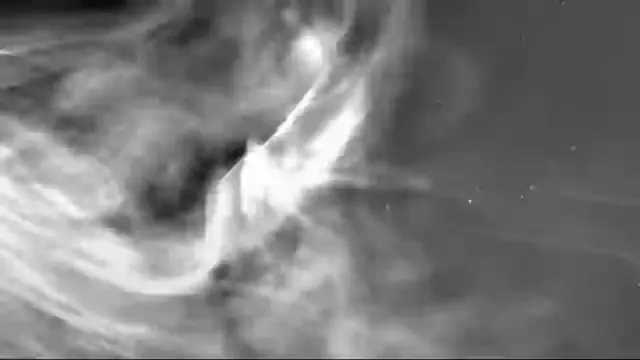
NASA releases closest-ever images to the sun and everyone is asking the same thing

NASA has unveiled new images capturing the Sun’s surface, marking the closest attempt to study it since the Parker Solar Probe’s groundbreaking mission last year.
The journey began when the Parker Solar Probe reached a record-breaking proximity to the Sun’s surface on December 24, coming within 3.8 million miles of the Sun. This was the first time a spacecraft ventured so close to sample the Sun’s atmosphere.
At this distance, the probe was seven times closer to the Sun than any previous spacecraft, making history by flying through the Sun's 'corona,' which reaches temperatures of about 1.8 million to 3.6 million degrees Fahrenheit (1 million to 2 million degrees Celsius). These bright, wispy structures are visible from Earth during a total solar eclipse.
Traveling at an astonishing 435,000 mph, the Parker Solar Probe remains the fastest object ever built by humans. During its record-breaking pass, it captured breathtaking new images, offering a never-before-seen look at the Sun’s atmosphere. These images are proving invaluable in helping scientists better understand the Sun’s effects throughout the solar system, according to NASA.
"With the Parker Solar Probe, we’ve been transported into the dynamic atmosphere of our closest star," said Nicky Fox, Associate Administrator for NASA’s Science Mission Directorate. He continued, "We are now observing where space weather threats to Earth originate, not just through models, but with real data. This breakthrough will significantly enhance our ability to predict space weather, ensuring the safety of our astronauts and the protection of Earth’s technology, as well as that of other planetary systems."
The images shared by NASA on social media stunned viewers, with many comparing the appearance of the Sun’s corona to wisps of smoke or ripples in water, illustrating the fluid movement of solar material.
Using a suite of scientific tools, including the Wide-Field Imager for Solar Probe (WISPR), the Parker Solar Probe revealed the intricacies of the Sun’s corona and solar wind—a continuous stream of electrically charged particles flowing outward from the Sun. These solar winds, along with eruptions of solar material and magnetic currents, play a crucial role in generating auroras, stripping planetary atmospheres, and inducing electric currents that can overwhelm power grids and disrupt communication systems on Earth, according to NASA.
By studying the solar wind, scientists hope to uncover more about the origins of the Sun and its far-reaching influence.
However, many viewers were skeptical about how the Parker Solar Probe could withstand such extreme conditions and still capture high-quality images. One person questioned, "How are they able to capture that with so much heat?" Another remarked, "It’s hard to believe that this is real... How can a camera survive that close to the Sun and still transmit a flawless feed? Surely communication would be disrupted."
In reality, the Parker Solar Probe is equipped with an advanced protection system. A hexagonal solar shield mounted on the sun-facing side of the spacecraft shields it from intense heat and radiation. This shield is made from a reinforced carbon–carbon composite and a carbon foam core, allowing it to endure temperatures up to 2,500°F (1,370°C).
So, despite the skepticism, the Parker Solar Probe’s sophisticated design enables it to survive and operate in conditions that were previously unimaginable.
News in the same category


Elon Musk's brother makes shocking claim Tesla CEO has not received any salary since 2017

Mortality experts explain real reason American millennials are dying at an 'alarming rate'

Antarctic Ice Sheet on the verge of a 'catastrophic' collapse causing irreversible damage

Apple release urgent new update for all iPhone users to fix major security bug

New Jersey man d:i:es while traveling to meet AI chatbot he fell for

Hiker Encounters Massive Snake Camouflaged Along South Carolina Creek

David Quammen, the COVID Predictor Warns of New Pandemic Threats

YouTuber shows crazy impact running 5k every day as a total beginner has on your body

Chilling moment Google's Gemini broke father out of delusion that he was 'changing reality' from his phone

Woman Cuts Her Hair for the First Time in 25 Years – See Her Transformation Today

This New ‘universal cancer vaccine’ trains the immune system to kill any tumor

Incredible cancer breakthrough sees woman's brain tumor almost disappear in just five days

NASA astronaut's heartbreaking statement from ISS moments before finally returning to Earth

Beware of the Plastic Bottle Scam: A New Car Theft Tactic

Former PlayStation CEO reveals key way consoles could be cheaper in the future

Swarm of angry jellyfish force nuclear power plant to immediately shut down

The TwoDaLoo Double-Sided Toilet (A Couples Toilet That’s Not For Me… Us)

Jeff Bezos reportedly 'obsessed' with making wife Lauren Sanchez the next Bond girl

Final straw that led to billionaire CEO's desperate escape from Japan inside 3ft box
News Post

Remedy For Falling Asleep Quickly

Ring Finger Longer Than An Index Finger

Sleeping Enough But Still Tired

Ways Your Body Secretly Tells You You’re Stressed

How to effectively cleanse your lungs in just 72 hours

Scientists find a berry that can combat cancer, diabetes, and obesity

She Spent $70,000 on Cosmetic Procedures — Now She’s Owning Her Beauty Despite the Backlash

Simulation Reveals the Science Behind Nightmares of Losing Teeth

Woman employed by popular mobile network sues company after being 'forced' to do nothing for 20 years

Insane simulation shows crazy impact of eating popular superfood everyday has on your body

Discovery Warrants Critical Rethink of Phantom Limb Pain Treatment

Can UV Light Reduce Infections in Long-Term Facilities?

Secret tip: How to clean glossy tiles at home without spending a penny

If your air fryer is rusty: Just do this and the rust will be easily cleaned

The surprising benefits of coffee grounds, if you have them at home, never throw them away

Eating sweet potatoes in the morning: A small habit, but you'll be amazed by the huge benefits it brings.

Effective and simple ways to restore a non-stick pan without needing to replace it

When the water pipe is completely clogged, just pour this down and it will be solved easily, no need to waste money calling a plumber.

Do you need to unplug the rice cooker after the rice is cooked? The answer is surprising.
